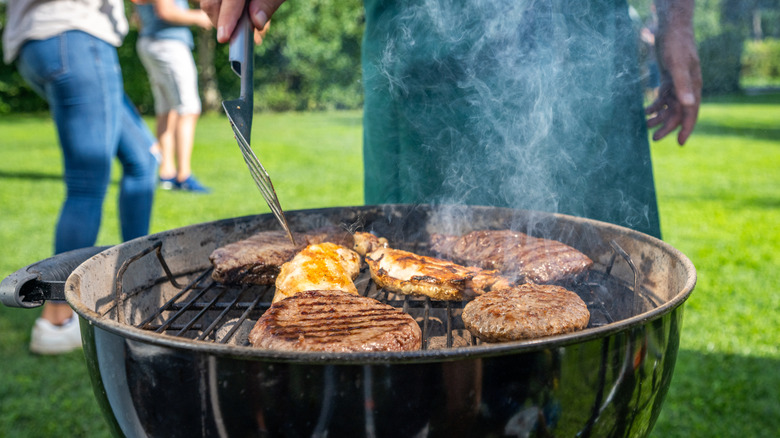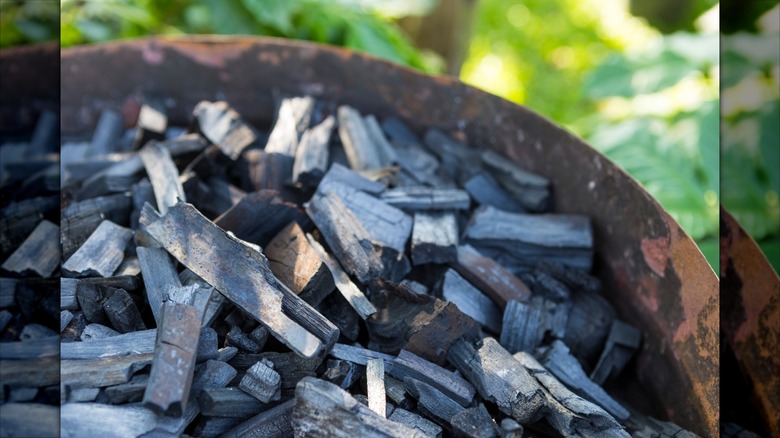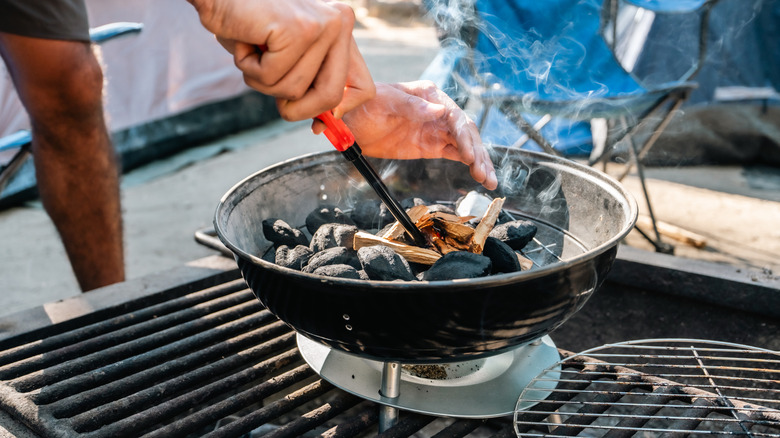
Simonkr/Getty Images
The charcoal that allows you to cook delicious recipes on the grill all summer long comes from wood that's been subjected to extremely high temperatures in an oxygen-limited environment. This process carbonizes the wood. You're probably most familiar with the bags of charcoal briquettes that proliferate grocery store shelves during the summer months. They're not your only option, however, as true grill masters can attest to the intense discourse that surrounds that age-old grilling question: lump charcoal or briquettes? Much of the answer depends on how quickly (or slowly) you need to cook your food.
For grilling novices, lump charcoal is an unadulterated form of carbonized wood that doesn't contain any additional elements. On the other hand, briquettes have additives, such as limestone, sawdust, and starch. The inclusion of additives affects how charcoal burns. Briquettes are known for providing extended consistent heat, whereas lump charcoal burns extremely hot but doesn't have the staying power.
Along with other common grilling mistakes like not resting your meat and cooking on dirty grill grates, choosing the wrong type of charcoal can have an unfortunate effect on your recipes. Fortunately, it's easy to make the right selection when you're aware of the strengths and weaknesses of charcoal types.
Lump charcoal burns fast and bright

sirirak kaewgorn/Shutterstock
You can easily identify lump charcoal because it resembles the hardwood that it's sourced from, albeit in a smaller, charred form. Lump can be made with a variety of hardwoods, including mesquite, oak, and maple. Because it lacks additives and fillers, this charcoal offers a clean burn.
It also infuses food with a woodsy flavor that varies according to the type of hardwood used. For example, mesquite imparts a smoky yet somewhat sweet flavor that's been likened to the taste of bacon. Maple wood is similarly sweet but less pronounced in terms of smokiness and not as likely to develop acrid notes, which is what happens when foods are over-smoked.
Lump charcoal can reach high temperatures and is easy to light, but it's also costlier than briquettes. And because it burns faster, it's not the best option for recipes that require extended cooking times unless you're willing to continuously add more for the entire grilling session. Foods that pair well with lump charcoal cooking include baby back ribs and chicken, as these already tender meats don't require low-and-slow methods to improve their texture. When it comes to finding the best lump products, look for specific hardwood species on the label or something that says the product consists of 100% hardwoods.
Briquettes are for extended low-heat cooking sessions

Halbergman/Getty Images
Unlike the pure and natural makeup of lump charcoal, charcoal briquettes consist of byproducts from other manufacturing processes, such as paper production. Charcoal fines, as they're called, make a powdery substance that lacks the heft and purity of lump charcoal, because they can include other substances like sand and clay. Once heat-processed, charcoal fines undergo a technique called briquetting, which involves mixing them with a binder. They are then pressed in a mold and dried in an oven before being packaged.
When it comes to the advantages of briquettes, they're affordably priced, easily accessible, and can burn for a lengthy period thanks to all those additives and special ingredients. Despite these benefits, the additives in briquettes cause a strong chemical odor when the charcoal first starts burning. Accordingly, you're advised to allow the briquettes to burn for about 15 minutes or so before placing food on the grill. This should get rid of any unwanted smells. Waiting until the briquettes turn to ash on the outside also ensures they're hot enough. This type of charcoal is best for something like brisket, which needs plenty of time to soften tough muscle fibers and melt fat, which will make for a juicier, more tender outcome.



